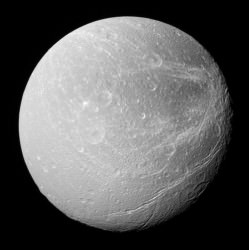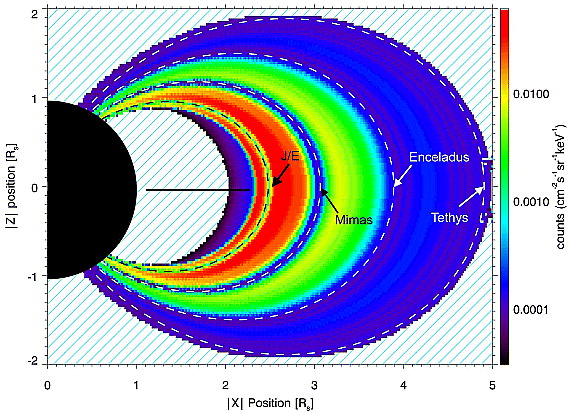[/caption]
A new, temporary radiation belt has been detected at Saturn, located about 377,000 km from the center of the planet, near the orbit of the moon Dione. The temporary radiation belt was short-lived and formed three times in 2005. It was observed as sudden increases in the intensity of high energy charged particles in the inner part of Saturn’s magnetosphere, in the vicinity of the moons Dione and Tethys, and likely was caused by a change in the intensities of cosmic rays at Saturn.
“These intensifications, which could create temporary satellite atmospheres around these moons,” said Dr. Elias Roussos, “occurred three times in 2005 as a response to an equal number of solar storms that hit Saturn’s magnetosphere and formed a new, temporary component to Saturn’s radiation belts.”
The discovery was made possible by Cassini’s five-plus year mission, allowing scientists to observe and assess changes in Saturn’s radiation belts. An international team of astronomers made the discovery analyzing data from the Magnetospheric Imaging instrument (MIMI) on Cassini MIMI’s LEMMS sensor, which measures the energy and angular distribution of charged particles in the magnetic bubble that surrounds Saturn.

The new belt, which has been named “the Dione belt”, was only detected by MIMI/LEMMS for a few weeks after each of its three appearances. The team believe that newly formed charged particles in the Dione belt were gradually absorbed by Dione itself and another nearby moon, named Tethys, which lies slightly closer to Saturn at an orbit of 295 000km.
Unlike the Van Allen belts around the Earth, Saturn’s radiation belts inside the orbit of Tethys are very stable, showing negligible response to solar storm occurrences and no variability over the five years that they have been monitored by Cassini.
Interestingly, it was found that the transient Dione belt was only detected outside the orbit of Tethys. It appeared to be clearly separated from the inner belts by a permanent radiation gap all along the orbit of Tethys.
“Our observations suggest that Tethys acts as a barrier against inward transport of energetic particles and is shielding the planet’s inner radiation belts from solar wind influences. That makes the inner, ionic radiation belts of Saturn the most isolated magnetospheric structure in our solar system“, said Dr Roussos.
The radiation belts within Tethys’s orbit probably arise from the interaction of the planet’s main rings and atmosphere and galactic cosmic ray particles that, unlike the solar wind, have the very high energies needed to penetrate the innermost Saturnian magnetosphere. This means that the inner radiation belts will only vary if the cosmic ray intensities at the distance of Saturn change significantly.
However, Roussos emphasized that outside the orbit of Tethys, the variability of Saturn’s radiation belt might be enhanced in the coming years as solar maximum approaches. “If solar storms occur frequently in the new solar cycle, the Dione belt might become a permanent, although highly variable, component of Saturn’s magnetosphere, which could affect significantly Saturn’s global magnetospheric dynamics,” he said.
The new findings were presented at the European Planetary Science Congress in Potsdam, Germany.


Though I understand what you meant with the sentence, upon reading…
“Unlike the Van Allen belts around the Earth, Saturn’s radiation belts inside the orbit of Tethys are very stable,”
… it is a little misleading.
(i.e. “so do Earth’s VA belts orbit outside the orbit of Tethys instead?” lol)
Jorge, if Saturn magnetic field efficiently traps solar wind, it would take long time for the particles to migrate away. They should be gyrating between the magnetic mirrors of the field poles as the particles in the figure.
So it’s not a flux, it’s a drift.
I found this data on GEOS measurements of Earth magnetosphere drift, topping out at ~ 20 km/s. More or less ballistic, I assume, comparing with gravitational escape velocity. That seems pretty high to me, and it’s _old_ measurements.
Essentially all drift processes goes as 1/B for weak electric field (surprise, surprise). Saturn magnetosphere strength is only ~ 600 times Earth, weak compared to Jupiter at 10 000 times. Then Saturn drift velocities may be on the order of 30 m/s for comparable scale heights.
That means such particles will drift ~ 5 000 km in two days. As Tethys is ~ 500 km in radius, and have no significant magnetic field [google] to help in collecting the particles, I’m off one order of magnitude.
[And I see plenty of descriptions of how observations of Tethys making a large plasma wake, so it definitely efficiently collects more plasma than I get at my back-of-the envelope sketch.]
Oh well, what is one order of magnitude between friends?
OK, there’s one thing I don’t understand here. I have no problems believing that Tethys may act as a barrier for particle transport in the vicinity of Tethys itself, but in the vicinity of its orbit?! How can Tethys have an influence on anything when it’s in the other site of Saturn? Even if it’s not a long orbit, it seems to me that a (almost) 2-day orbit leaves plenty of time for particle flux in a given region between successive passes.
On the other hand, this magnetic stuff is probably where the depth of my ignorance is larger, so there may be some entirely logical explanation. But I really don’t see how it can be.
Torbjörn Larsson OM, thanks for those links — especially the third one!
That’s what I like about the comments section here: we all help each other; well, er… most of us do, unlike that shady character named after a friggin’ snake!
@ Sirius_Alpha,
That sentence, which you refer to, looks O.K. to me; what’s ambiguous about it?
anaconda trolling noted.
@ Pvt.Pantzov,
I mentioned no name in reference to that individual…
where did i claim that you did?